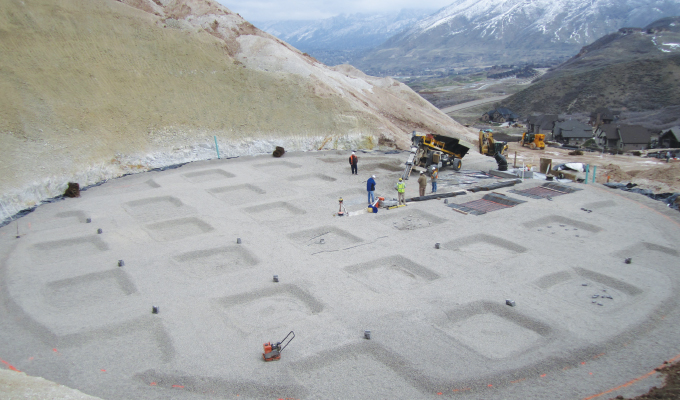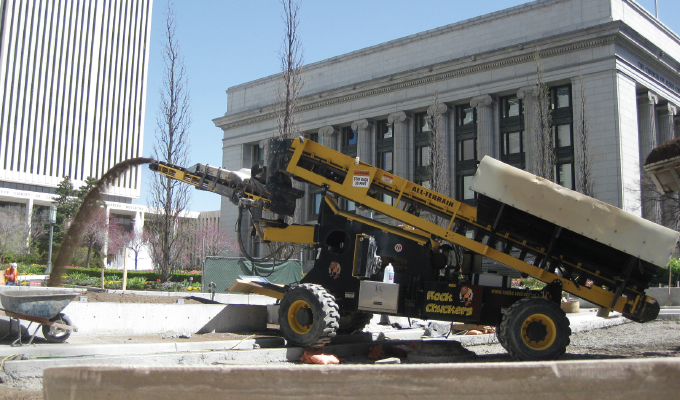How to be competitive in a changing world
By Don Lindsey
Change: one word, six letters, but so big and heavy just mentioning it causes most to clammer. However, for the few embarking upon the mission of “change,” they oftentimes find themselves in a world many miss out on, and in doing so create a competitive advantage, which makes the competition for the most part irrelevant. A perfect example of this is Rock Chuckers, in Salt Lake City, Utah.
President Danny Johnson started working in the industry in 1998. Prior to the recession in 2008, good times were to be had in the Utah construction industry. Salt Lake City had a plethora of construction projects underway as a result of hosting the 2002 Olympics. Business men and women from all over the world visiting Utah found an industrious people and a boom hit Utah as companies either moved or started new branches, distribution lines, and manufacturing.
When Danny first started in the industry, he quickly saw most companies operated in a traditional manner. From the way they costed/priced out services to the scheduling/handling of materials, operations were traditional in how they functioned, which caused a number of inefficiencies. As a result, Danny began introducing Slinger Trucks to the robust Salt Lake construction industry, and although he was having success introducing this new “technology,” the economy was good and most were doing quite well so there was no real motivation to try something new.
When the recession “officially” ended in mid-2009, it would take another 4-5 years for the construction industry as a whole to rebound. When it finally did, an industry emerged that was quite different.
Danny explains, “We all emerged to an entirely different industry, which was driven by the customers’ wants and needs. Our ability to adjust to the customer and do it profitably would determine who was going to come back and have a successful business and who would fade off into the sunset.”
Most saw this new operating environment as a significant obstacle but Danny saw it as a great opportunity. He could now begin to fully address the many inefficiencies within the industry so many others had just accepted as a “cost of doing business.”
MATERIAL MOVEMENT
All construction projects begin and end with some sort of material. Contractors need material to do things, such as provide a solid base for the foundation or backfill for foundation walls. When the project is complete, finishing material is brought in to landscape the common areas. This movement of material was where Danny saw the greatest opportunity but it was going to require a total reset in most contractors’ thought process, with his own challenged as well.

Throughout the construction industry, moving material went something like this:
Dump trucks went to the material’s location, which in most cases was the rock quarry. The trucks would get loaded and commute to the construction site. Depending on the time of day and the jobsite location, this commute could take a few minutes or several hours and sometimes even longer on projects in large metropolitan cities. The distance of the material’s location would determine how many trucks were ordered to deliver the required amount of material. Once the trucks arrived, the delivery was precisely coordinated and consisted of a partial load being dropped at a particular point with the remainder going elsewhere or the full load being delivered at a single location. Once the load was delivered, the truck(s) would make the round trip to the quarry, which again could take several hours. While the truck was making the round trip, equipment operators in various types of heavy equipment would relocate the material into the correct areas and/or to a finish grade. This was a repeatable process that had not changed much over the years and was fairly consistent from one project to the next.
Post-recession, Danny’s “Slinger Truck” way of moving and placing material was growing in popularity as contractors sought out new ways to be more competitive in this new working environment. Suddenly, the motivation to CHANGE became stronger, which again reminds me of a saying my daddy would say: “Son, folks won’t change unless the pain of NOT changing is greater than the pain of changing.”
MINIMIZING DOWNTIME
Rock Chucker’s fleet of Slinger trucks steadily increased as they repeatedly delivered massive amounts of material to a precise grade in a fraction of the time it would take with the more “traditional methods.” However, anyone knowing Danny Johnson knows he is a constant perfectionist and would not rest until he solved the “downtime” puzzle his Slinger Trucks were incurring as they made the round trip to be reloaded. This downtime was costly and he either had to purchase more trucks or figure out how to increase the productivity of what he had. This eventually drove Danny to look into different types of Slingers, which led him to an all-terrain Slinger built by Conveyor Application Systems (CAS®).
CAS manufactures a remotely operated heavy-duty all-terrain Slinger designed to function on all types of terrain. When Danny first saw the CAS unit operate, he was cautiously optimistic but admittedly had a hard time seeing the advantages over a Slinger Truck. Then it clicked. Like the traditionalist who were steadfast in their own system of moving material, Danny had to change his own way of thinking. So, he conducted an analysis of the job types his company was taking on and the cost of the downtime he was incurring. Putting a monetary figure to this downtime, increased Danny’s motivation. Suddenly, CHANGE was in the air!
PIVOTAL MOMENT
Danny decided to make a big change and match up his Slingers according to the VOLUME requirements of the project along with the accessibility of the jobsite and/or its location. Moving forward, he would put the CAS all-terrain Slinger on large volume projects and the Slinger Trucks were assigned to jobs requiring multiple stops or smaller volumes of material. This radical change garnered more than a few “odd” looks but Danny was steadfast in his belief that he could eliminate downtime completely by staging the material at the jobsite prior to his equipment and crew ever showing up. Once the material was properly staged and not a second sooner, would he then dispatch an all-terrain Slinger, a front-end loader and two operators. This combination worked in concert as the front-end loader kept the all-terrain Slinger loaded and the all-terrain Slinger placed the material to a laser-leveled finish grade.
CLOSING THOUGHT
This continuous operational scenario gave Danny the full production efficiency he had been seeking by completely eliminating downtime. The puzzle was solved. Danny shares, “It was so simple but yet so complex; all I had to do was change my own mindset.”
About the author:
Don Lindsey is the director of sales and marketing for Conveyor Application Systems.
Modern Contractor Solutions, January 2020
Did you enjoy this article?
Subscribe to the FREE Digital Edition of Modern Contractor Solutions magazine.



